| clevescene.com | Apr 9 - Apr 22, 2025
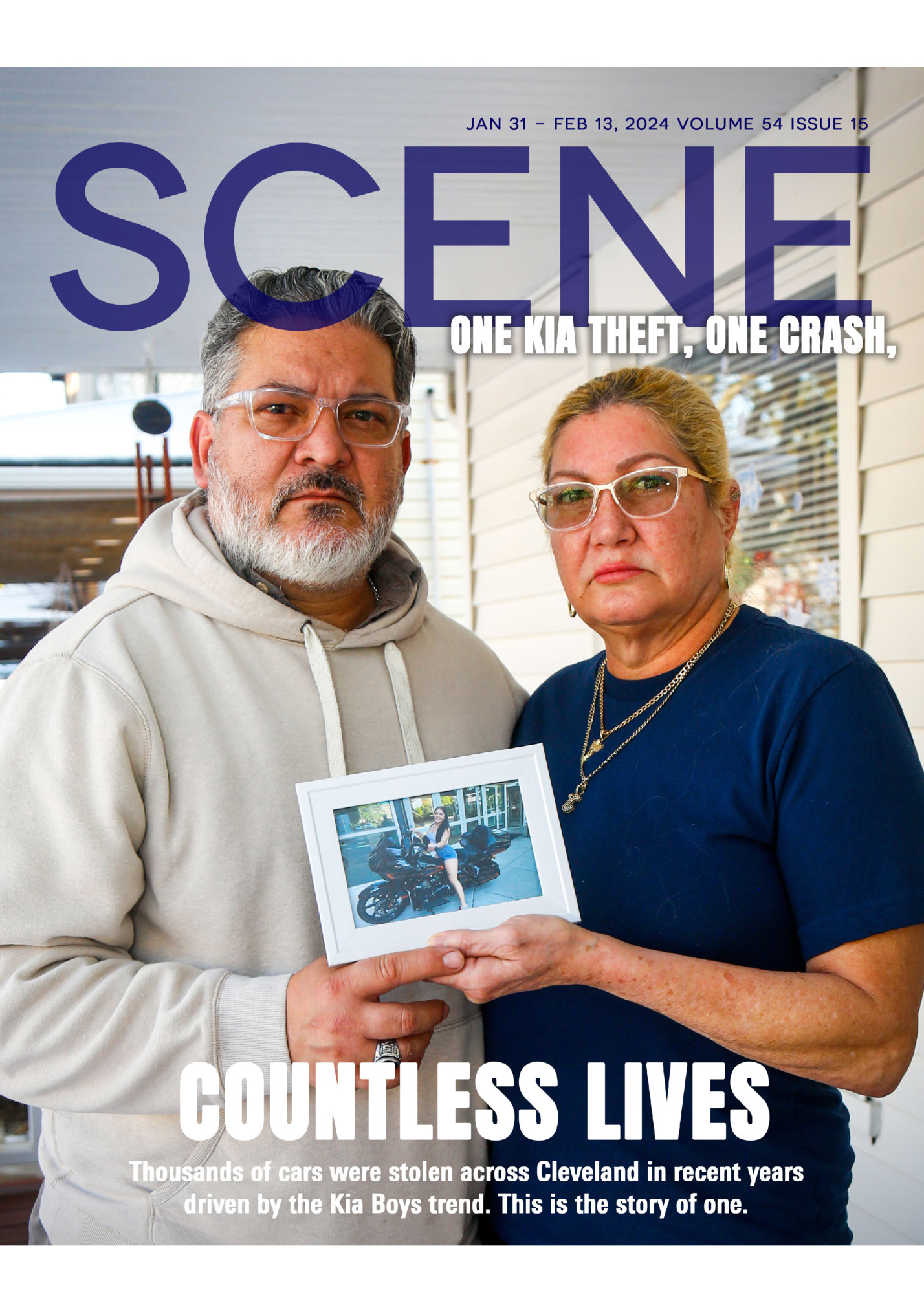
| clevescene.com | Apr 9 - Apr 22, 2025

3

APR 9 - 22, 2025 • VOL. 55 No 19 Upfront .......................................7 Music ........................................19 Feature .......................................8 Livewire....................................20 Get Out .....................................12 Savage Love..............................22 Eat ............................................15 Dedicated to Free Times founder Richard H. Siegel (1935-1993) and Scene founder Richard Kabat Publisher Denise Polverine Editor Vince Grzegorek Editorial Music Editor Jeff Niesel Staff Writer Mark Oprea Dining Editor Douglas Trattner Stage Editor Christine Howey Advertising Sales Inquiries (216) 505-8199, scene@clevescene.com Senior Multimedia Account Executive Shayne Rose Creative Services Graphic Designer Ana Paula Gutierrez Staff Photographer Emanuel Wallace zine. Cleveland Scene is a Verified Audit Member Great Lakes Publishing President Lute Harmon Jr. Finance Director Perry Zohos accounting@glpublishing.com Operations Manager Corey Galloway www.glpublishing.com Cleveland Distribution Scene is available free of charge, limited to one copy per reader Subscriptions - $170 (1 yr); $85 (6 mos.) Email Kristen - KBrickner@ClevelandMagazine.com - to subscribe. Cleveland Scene 1422 Euclid Ave. STE 730 Cleveland, OH 44115 5 55 years 1970-2025 REWIND: 2015 Ten years ago, Tito led the way to an 81-80 season where Cleveland missed the playoffs. Despite how the early results have panned out so far this year, we’re holding out hope that’s not how this campaign goes. Business Traffic Coordinator Paige Schuller Circulation Circulation Director Burt Sender Take Cleveland Scene is published every other week by Omit the Maga- Copyright The entire contents of Cleveland Scene Magazine are copyright 2024 by Great Lakes Publishing. Reproduction in whole or in part without written permission of the publisher is prohibited. Publisher does not assume any liability for unsolicited manuscripts, materials, or other content. Any submission must include a stamped, self-addressed envelope. All editorial, advertising, and business correspondence should be mailed to the address listed above. Subscriptions $170 (1 yr); $85 (6 mos.) Send name, address and zip code with check or money order to the address listed above with the title ‘Attn: Subscription Department’ ...The story continues at clevescene.com 4 | clevescene.com | Apr 9 - Apr 22, 2025 SCENE with you with the Issuu app! “Cleveland Scene Magazine” COVER DESIGN BY ANA PAULA GUTIERREZ.

5

CLEVELAND HEIGHTS MAYOR KAHLIL SEREN DEFENDS WIFE’S UNOFFICIAL ROLE AT CITY HALL AMID RISING TURMOIL, STAFF DEPARTURES WHEN DAN HORRIGAN recently resigned as the City Administrator of Cleveland Heights after less than three months on the job, his ensuing comments about his departure brought to public light a simmering issue that had been festering for a while. Horrigan, the former mayor of Akron, shared the reason behind his mere months on the job with a reporter for the Akron Beacon Journal. Horrigan was cryptic but clear: a tense office culture at Mayor Kahlil Seren’s City Hall was the focal point of his resignation. “I raised a number of workplace safety and hostile work environment issues that involved a member of the mayor’s family that were not addressed, and it kind of made the administration of my duties untenable,” he said. Horrigan had elaborated, in private communications to Seren on March 14, who he was really talking about: the mayor’s wife, Natalie McDaniel. “The work situation is untenable at this point,” he told Seren. “I realize that this is a difficult and personal situation, but your wife’s presence here at City Hall has caused a number of employees to feel uncomfortable and on at least one occasion, unsafe.” “Quite frankly,” Horrigan added, “her directing staff in their official 6 capacity is improper and unethical.” Seren himself has faced internal and external criticism that’s run the gamut from concerns about expenditures in an overdue budget proposal to funding at Cain Park. For the dedicated and watchful residents of Cleveland Heights, Horrigan’s drive-thru stint under Seren wasn’t an anomaly. Danny Williams, the City Administrator before Horrigan, retired after a year in office. Joe Sinnott, Williams’ predecessor, after a year, as well. As did Patrick Costigan, Seren’s assistant, in January. As did Jessica Rosenblatt, a marketing specialist. As did three finance directors, two Parks & Recreation directors, a communications director, a payroll administrator and the general manager of Cain Park. In a general sense, at least a dozen current and former employees told Scene, there’s a culture of intimidation that’s gotten out of control, and McDaniel is a co-star. “During my time there, there was a constant atmosphere of fear,” Jessica Rosenblatt, a former marketing manager for Cain Park who quit last August, told Scene. “The mayor does act more like a dictatorship. And if you do upset him, or his wife, you know, your job is at risk.” For several members of City Council, McDaniel’s influence at City Hall is | clevescene.com | Apr 9 - Apr 22, 2025 more of a symptom of Seren’s wrangling of his executive seat more than, say, a matter of happenstance. “I’ve heard she has meltdowns in City Hall,” one told Scene. “She’s gone ballistic at employees, reprimanding them. She sits in hirings and firings. She has a keycard to get in and out of offices. It’s all just ridiculous.” “I just don’t understand why she’s there,” another said. “That’s my biggest confusion at this point.” In the public eye, McDaniel appears as mysterious as she might seem to those at City Hall she’s helped hire and fire. She’s lived in Cleveland Heights for at least a decade and been married to Seren for about that long. She was at his swearing-in for City Council on February 18, 2015. She worked for the Department of Veterans Affairs for eight years. Her tenure alongside Seren is a lot more unclear: McDaniel’s not listed in the Cleveland Heights staff directory, or on the city’s website at all. And McDaniel is not a stranger to accusations of workplace hostility. In September 2015, McDaniel sued the VA for forcing her back to the office after she claimed her Post Traumatic Stress and anxiety gave her a right to work from home. McDaniel said she was forced to quit, the suit reads, due to a “hostile work envi- ronment/harassment; discrimination based on race and gender (McDaniel is Black), disability and retaliation.” A judge dismissed the case, in February 2019, opining that McDaniel did not have sufficient proof that, a summary judgment reads, a “few, isolated incidents of alleged harassment do not create a hostile work environment.” In a half-hour interview with Scene on Monday, in a board room at Cleveland Heights City Hall, Seren defended McDaniel’s role over the past two years, framing his wife’s position as a natural extension of his seat. McDaniel, he said, is his “first lady.” She is unpaid. She has no “formal set of duties.” She is a sidekick to his political reach. (None of which is mentioned in the city charter.) It is “as you would expect from any person in any public office who has a partner in their life—this is not unusual,” Seren said. “One would expect that Barack Obama sought Michelle Obama’s counsel on many things. You would expect that Richard Celeste sought Dagmar Celeste’s counsel on many things,” Seren added. “You would expect these things because it makes sense. This is a person who knows me well. This is a person who understands.” As for the emails pointing to an incident involving McDaniel on March 13, Seren asserted that an indepen-
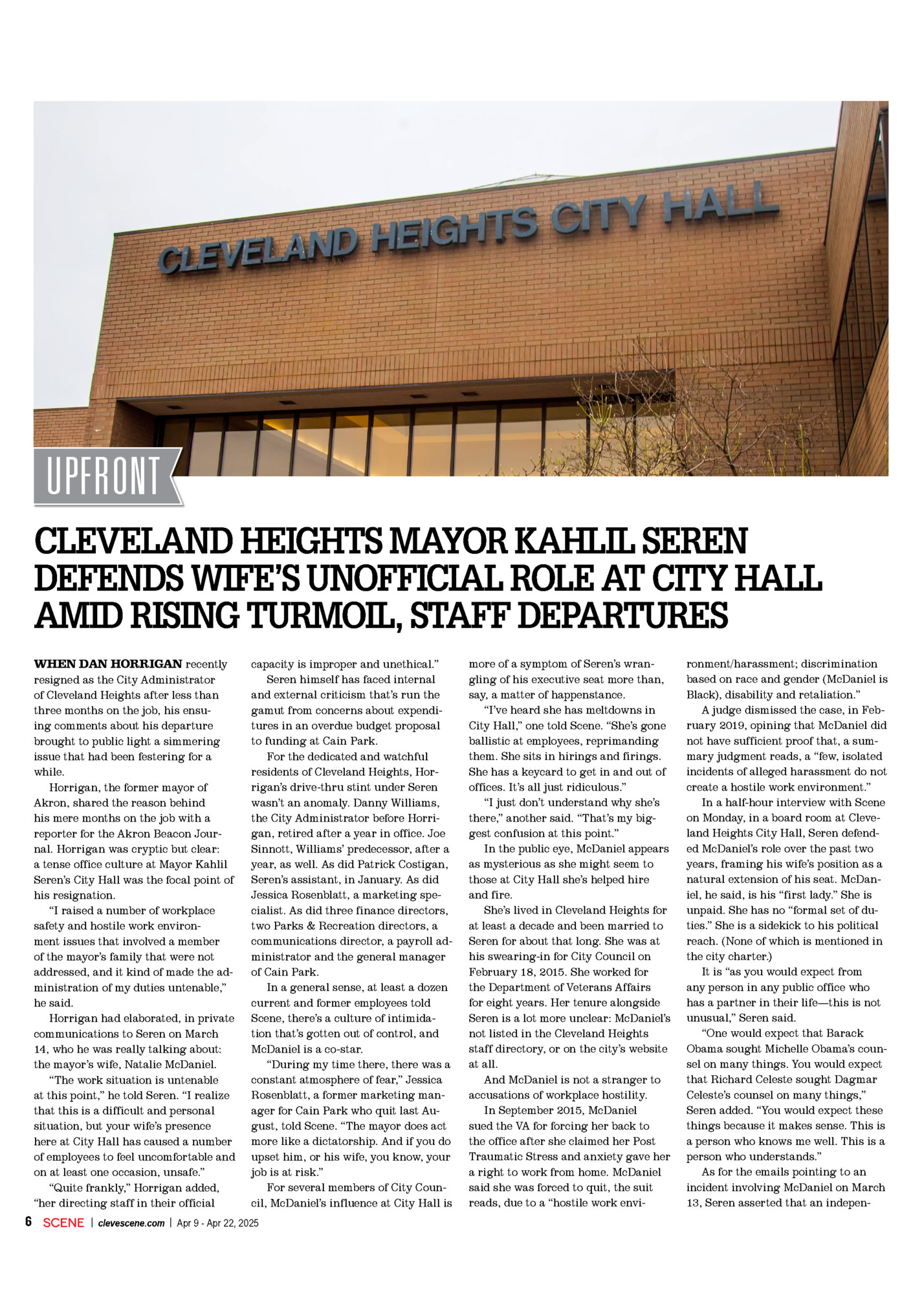
accusations of hostility. Seren said he received “no complaints of that nature” until Horrigan’s mention of it surfaced in the middle of March. Since Seren took his oath of office on January 1, 2022, the 46-year-old former city councilman adopted a wholly rigid and stern philosophy around bringing Cleveland Heights away from its financially distraught past. Seren admires a Lean Six Sigma-type of approach to managing City Hall’s denizens—an office mindset obsessed with waste reduction and worker efficiency. He even hired a performance coordinator, Andrea Heim, last year, to advance “that ethos across all departments,” as a 2024 Mid-Year Report states. (Last week, Heim was put on administrative leave, multiple sources confirmed.) “I don’t think that everybody has an understanding of sort of what process-improvement methodology is for,” he told Scene. “My goal is always to make the work that people do for the city as easy as possible,” Seren added. “I have no desire to make it harder for any public employee to do their job. I think that there are always ways for us to find unnecessary steps in processes and remove them—so no, I don’t think we’re setting the bar too high.” As for the departure of three city administrators and other employees in recent years, Seren responded: “There are certain things that—it’s sort of not really okay to say about a departing employee getting into their personal lives.” A And as for Horrigan: “Unfortunately, again, we come back to this sort of jumping to conclusions,” he said, “and determining that what a director says as they’re leaving is not credible unless it’s something that they already believe.” If Seren chooses to run for re-election, he’ll go up against contenders in a September primary election, then again in a November general election. Based on past comments, it seems Seren feels fine exiting the seat without further controversy, and, as he phrased it in a December Council meeting, take his talents elsewhere. “I’ll be fine,” he told the room. “I can land on my feet. I have opportunities elsewhere.” – Mark Oprea Cleveland Health Survey Shows Residents Struggle to Meet Basic Needs With the first citywide survey in about a decade, the Cleveland Department of Public Health now has a clearer picture of the city’s general health. Results began to be released this week with the publication of the 2025 Cleveland Health Survey data snapshot. From November to January, with help from nine students at Case Western, thousands of postcards were mailed out to Clevelanders in all 34 neighborhoods of the city. A sample size of 1,497 people responded to 90 questions, from how often they smoke menthol cigarettes to how often feel depressed. And, well, we’re not looking too great. For starters, we have higher obesity rates (39%), diabetes rates (16%) and high blood pressure (46%). We’re depressed more often (37%) and feel less social (58%). We’re also seeking food assistance more often (30%), receiving SNAP (33%), own fewer homes, need help paying rent and utilities, and have a tougher time securing rides to work (18%), or just keeping constant work altogether (17%). Yet Dave Margolius, the head of the Department of Public Health who helped direct the survey, feels the tough truths the survey shows us outweighs the distressing feeling that the city isn’t improving. Or, as the philosopher Krishnamurti once said: It’s best to just see what is. “You just can’t improve what you’re not measuring,” Margolius told Scene. “I’m really grateful that we now have the most up-to-date health statistics of any city,” he added, “and probably any place in the country.” And having a good read on Cleveland, or at least 1,500 of us, may be more timely than ever. The recent string of federal cuts to tree canopy restoration work, food for the Greater Cleveland Food Bank and those receiving Medicaid could impact one-third of the city. All that and other issues mean a greater reliance on City Hall to brainstorm, and legislate, ways to keep Cleveland healthy despite lost aid from the feds. “I know that our goal is that this data, it doesn’t just sit on the shelf,” Ward 12 Councilwoman Rebecca Maurer, who’s also co-chair of Council’s Health, Human Services & The Arts Committee, told Scene. “It has to inform the actions that we take as a city and the programming that we put into place,” she added. “I don’t think it should come as a surprise to Clevelanders, but we have to figure out how to turn this into actions and programs in the real world.” A committee meeting to unpack the survey data is to come soon, Maurer said. But Maurer was clear that City Council does have the choice to put data into reality. She pointed to Slavic Village, where $150,000 went into a full-on renovation of the Stella Walsh Rec Center. Sure, Slavic Village is a poster child of the effects of redlining—but, in Maurer’s mind, it’s gained access to a new place to exercise. “I mean, we now have the most top-of-the-line weight room and gym equipment in the entire city recreation network,” she said. The Department of Public Health will be releasing a more detailed breakdown of the data sometime later this month, Margolius said. For example, data showing how smoking rates were reduced by some 15 percentage points since 2015. (Or were, Margolius mused, just replaced by vaping culture.) But small victories aren’t passed over easily. Which is part of the reason Margolius hopes that 2025’s data paves the way into the city realizing the incentive of not waiting as long to do the next one. “Our hope is that we would do this every three years,” Margolius said, “instead of every ten.” – Mark Oprea People’s Budget Cleveland Group to Launch $100,000 Participatory Budget Pilot Program People’s Budget Cleveland, the team of advocates that believe Clevelanders should have a greater say in how their tax money is spent and got a participatory budgeting ballot issue before voters in 2023, is giving their efforts another go with a pilot program. Starting in May, PB CLE will begin six months of research and listening for a $100,000, privately funded version of their idea in one Cleveland neighborhood. (That neighborhood has yet to be selected.) The bid in November 2023 to direct $14 million of Cleveland’s coffers to a People’s Budget Fund failed by a slim margin, of just 1,387 votes. A year of regrouping has seemed to led to renewed faith: Clevelanders want greater say in how their dollars are spent on public projects. “We saw the election as not everything we wanted. And we also saw it as an affirmation, that a substantial number of people in Cleveland want a democratic way of making decisions— real decisions. And we want to see that goal in Cleveland. The pilot is a way of doing that,” PB CLE’s Jonathan Welle told Scene. With federal funding cuts, Clevelanders will see a handful of projects tabled or delayed. The pilot program will be a chance to give one neighborhood a shot at, well, calling their own shots. “This work is even more important now, at the time of rising authoritarianism,” PB CLE’s website reads, “because a People’s Budget harnesses the collective wisdom of Cleveland residents and builds neighborhood power.” A program manager, to be hired this month, will help spearhead idea gathering. Clevelanders can have their say on the best candidate through a questionnaire that wraps up April 15. There’s no denying that $100,000 doesn’t compare to City Hall’s meaty, $172 million, three-year budget for capital projects, for public pool rehabs, new football stadiums and Irishtown Bend Park. Or the $14 million slice a steering committee could’ve wrangled if Issue 38 had passed. But that hasn’t stopped the group completely. “People want to see school projects, beautification projects and safety projects,” Andrea White, a PB CLE committee member, told Signal. “They want to see an uplift of their neighborhoods because they do not see that at this present moment. This pilot can change that.” Residents voting on how to spend pooled money exists in some form—a county government, a school—in over 7,000 cities throughout the world, the Participatory Budgeting Project found. In 2018, We Decide Detroit helped cobble together $250,000 to spend in and around Clark Park, situated in a Hispanic-majority neighborhood. Months later, after focus groups and votes casted, neighbors made up their minds on how to spend it: $72,000 for outdoor music; $50,000 to fix up Clark’s ragged gazebo; and $139,000 to build a small, ADA-accessible playground for children. Yet, the neighborhood’s somewhat paltry voter turnout—just nine percent neighbors—rasies questions about the aspirations of true democracy underlying participatory budgeting. And projects in other cities weren’t too far off: just two percent of neighbors showed up to vote in one in Cambridge, Mass.; another one, in Chicago, just one percent. Any recommendations, in the Clark Park case, hinted at actually consulting City Hall rather than shunning local politicians altogether. “Involve the city sooner,” a follow-up report on the project read. “Involve a highly trusted elected official known for their grassroots connections earlier in the process.” PB CLE is slated to host a kickoff event sometime in May. – Mark Oprea scene@clevescene.com t@clevelandscene Apr 9 - Apr 25, 2025 | clevescene.com | 7
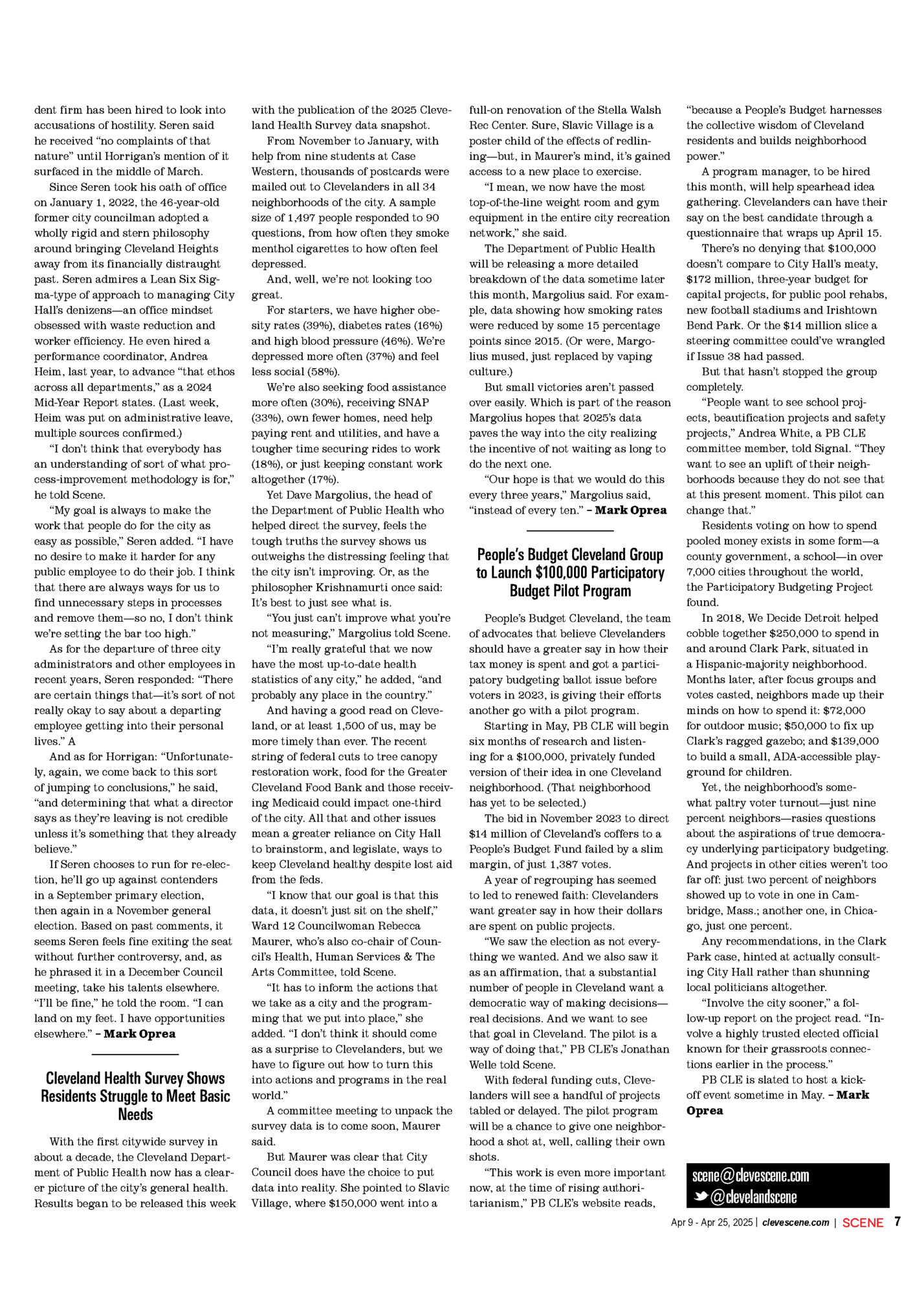
ONE KIA THEFT, ONE CRASH, COUNTLESS LIVES CHANGED Thousands of cars were stolen across Cleveland in recent years driven by the Kia Boys trend. This is the story of one. By Mark Oprea THERE WAS A SPECIAL kind of electricity on Natchez Avenue the morning of August 3, 2023. And it kept Carmen Gandarilla up most of the night before. A type of excitement, amplified by distance and time, that revolved around one single thought: my Janet is finally coming home for good. The Reyes family would make the most of the moment. Carmen made brunch plans at Gus’s Family Restaurant down the street. Brother Tato cued the FaceTime from New Jersey. Stepfather Alberto would take the photos. Sisters Gardenia and Leslie would cook the pork pernil and tostones, supply the Tito’s. Best friend May scheduled the nails and hair appointment. Janet had spent the past two years in Surprise, Arizona, living with a boyfriend, Orlando, and newly 21 years old, carving out a life she felt worth pursuing in the years ahead. “And she loved her family,” Gardenia said. “She’s not used to being by herself. She always had somebody.” And Janet had Natchez. That is, despite a long-standing urge to find new experiences or challenge her mother in ways daughters often do. There was that colicky baby’s endless crying. That teenage itch to push boundaries—to sneak a serpent tattoo, to go clubbing late at night (“midnight cats,” Grandma Luz used to call them), to abandon volleyball and swimming for the Rhodes High basketball team. And the cycle of career ideas: National Guard? Nurse at MetroHealth? And the endless Janets to show the world: straightened hair, raven-black curls past her shoulders, long braids, red streaks. “She was very free-spirited,” Carmen said. “Since she was a baby; she didn’t care. She wasn’t afraid to get into trouble. She wasn’t afraid to stand up to you.” It was that Janet that flew into Cleveland-Hopkins the morning of August 3. After a burger at Gus’s with Carmen, Janet waited for May at the house on Natchez as Gardenia and middle sister Leslie prepared food for her homecoming party. Around three, May and Janet drove to a salon off Pearl in Old Brooklyn and left two 8 8 hours later with nails newly pink. Driving home, May posted a photo on Instagram of Janet in the passenger seat smiling, dancing to reggaeton, hair all fresh in braids. Four minutes later, as May and Janet were turning at a green light onto State Road, blocks away from Natchez, a 2016 black Kia Optima slammed like a missile into the right passenger side door at 88 miles an hour. May’s car ricocheted like a toy. It tumbled into the mulch bed of a nearby plaza center. Airbags deployed in both cars. Debris lined half the road. The entire right side of May’s Honda was cratered. It was about then a text popped up on Janet’s phone, one that she would never see. Where are you at? We’re waiting, Gardenia wrote. Come on. Gardenia left to go buy Tito’s at West Side Beverage. She’d seen Janet’s location on her phone close by on State, so she drove over to meet her. She found instead a flurry of police lights. “Something was going on,” she recalled. “They were running to their car. I thought, ‘Something wrong has happened.’ So, I drove over there. | clevescene.com | Apr 9 - Apr 22, 2025 | clevescene.com | Feb 26 - Mar 11, 2025 I parked on the street, and started running towards them.” She paused. “I just knew. I knew my sister was in that car.” Janet died almost instantly. “She never made it home,” Gardenia said. “I never got to see her that night.” May was rushed in critical condition to MetroHealth—as were the four in the Kia Optima —in an unconscious state. She was hospitalized for a month with a traumatic brain injury and lost an eye. The next day, Carmen and Alberto were interviewed by Cleveland 19 News. They were told that driver in the Kia, like the three others in the car, were just teenagers. The youngest was only 12 years old. “I’m going to do everything in my power to make sure those kids stop,” Carmen said. “Something has to happen. We all got to get involved. We got to put a stop to this.” THE YEARS-LONG phenomenon of the Kia Boys—the groups of mostly male, mostly teen-aged car thieves that break into quick-to-steal Kias and Hyundais of certain years and models with the aim of bragging about their score on TikTok, YouTube or Instagram for clout (and, in many cases, to use the vehicles to commit other crimes)—represents a failure of society with no real answers. Who is to blame? Is it the Chinese car manufacturers who neglected for years to install anti-theft devices in their products? Is it the fault of cops, muddled by understaffing and stringent chase policies? Is it juvenile court judges, stuck in the quagmire of high case loads and a crammed detention centers? Is it the social media corporations, thriving on likes and ad dollars, who’ve failed to keep minors off the Endless Scroll where those how-tosteal-a-Kia videos first prospered? Or, as has been popular amongst some city councils and the court of public opinion: Is it the parents, our first gate of acceptance and punishment, who should bear the weight, despite the burdens of single parenthood and poverty, of the actions of the The aftermath of the crash that killed Janet Reyes. | Mark Oprea
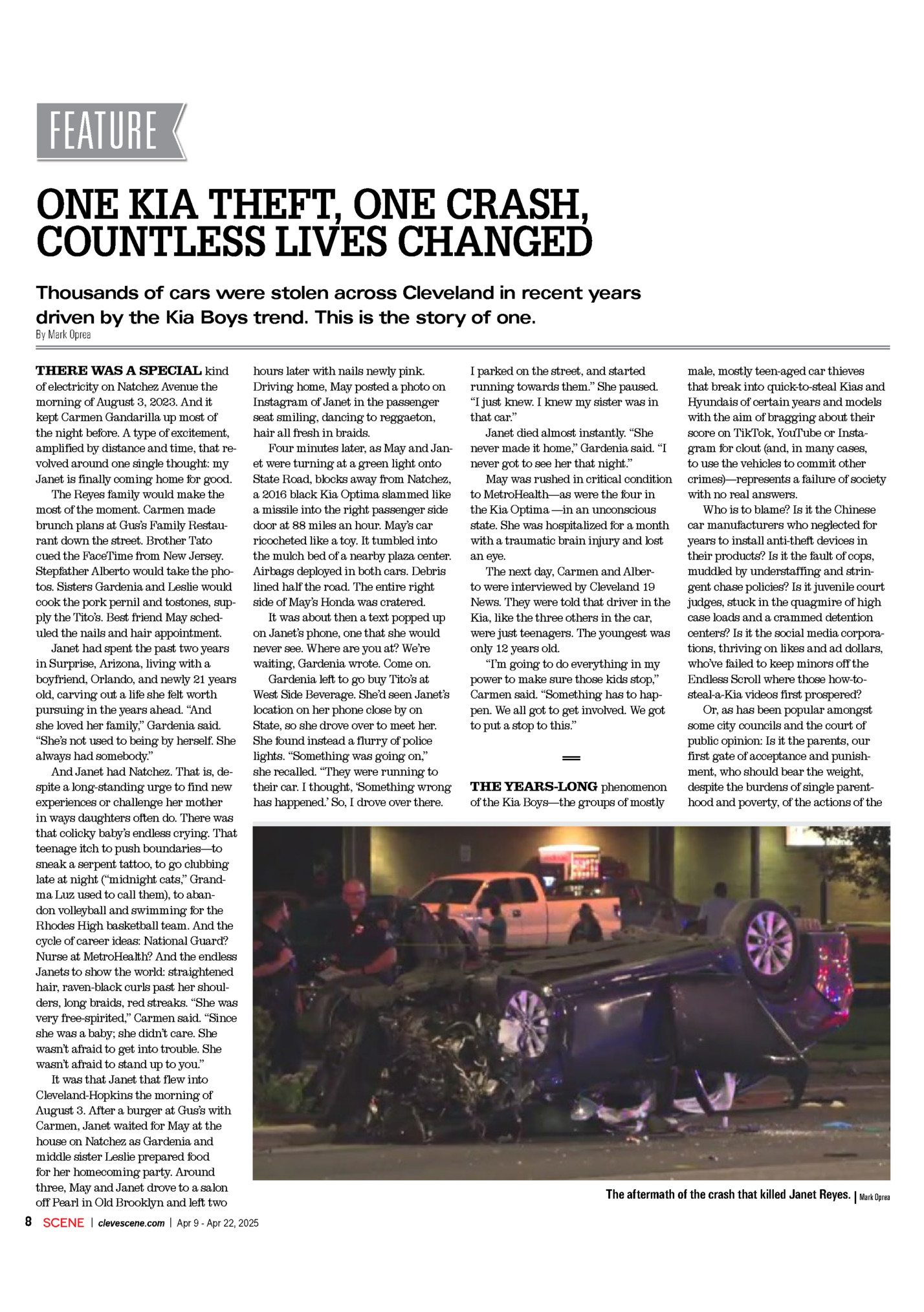
stealing cars? What has happened in the four years after the #KiaChallenge first blew up on TikTok is the culmination of a public reckoning with its most heinous effects. Whether that be in new juvenile home detention programs; tightened city curfews; federal class-action lawsuits; steering wheel lock device handouts; curtailed, “kid-friendly” forms of apps; and a looming national ban on TikTok altogether. But there’s a general consensus, from attorneys and parents and experts, that the problem of the Kia Boys isn’t letting up anytime soon. In the year after Janet Reyes was killed in that Honda Accord in Old Brooklyn, Cleveland Police reported 4,356 cars stolen across the city. Forty percent of those cars were Kias and Hyundais. And about a fourth to a fifth of those 1,645 cars, FBI data suggests, were stolen by minors. “You know the root of all this? Nothing happens to them when they get arrested,” Ward 8 Councilman Michael Polensek told Scene early last year. Disgusted by the crash that killed Janet and hospitalized May, Polensek spent weeks after urging City Council to tighten what he saw as outdated and soft curfew laws. (By about an hour for most ages.) He also wanted to revise city code to charge the parents of teen car thieves with intensified misdemeanors—slapping them with fines, and possible jail time. By the end of 2024, the city reprimanded 113 teenagers and parents for curfew violations since the new curfew laws went into effect. “I mean, that’s part of the problem,” Polensek said in January. “They get arrested, and tossed right back out. Especially if they’re juveniles. It’s a license to continue what you’re doing: they all know the cops aren’t going to chase them.” Cleveland Police policy aside, minors caught stealing cars will find their way to the Cuyahoga County Juvenile Justice Center and in front of one of the court’s six judges. It’s where 14-year-old C.H. found himself after he drove a Kia into a group of teens heading home from school last May. It’s where four teens donning black ski masks, passing 75 MPH and crashing off West 85th, found themselves in June. And it’s where six ended up after a precarious, six-minute chase with Garfield Heights Police on August 12, that ended with them fleeing on foot off East 131st. Which ended quite a busy streak for those offenders: those kids were responsible, CPD concluded, for at least seven other thefts that summer. Yet, with all of the implications of 14 year olds zooming down city streets at speeds meant for turnpikes, judges A makeshift memorial at the crash site. | Mark Oprea at CCJJC denied to send at least half of these kids to detention. Most were released to their parents, either on probation or with a GPS-equipped ankle monitor. At least five of these teenagers, Scene found, were involved in Kia or Hyundai thefts not even a month after their arraignments. And, according to the County Prosecutor’s Office, just 61 of their 3,277 total cases had minor defendants who were bound over to the Justice Center downtown to be tried as adults. (CCJJC denied Scene’s request to talk to specific judges about their sentencing philosophies.) “That’s exactly why I’m on these kinds of cases. Otherwise, this would have never been a case that would’ve come out of Juvenile Court,” prosecutor Kevin Fillatraut told me. He was walking out of a fifth-floor courtroom at the Justice Center in March. A 16-year-old named Jayrion Church had shot a Cleveland police police detective Mark Bahrijczuk after crashing a Kia he’d stolen on Cleveland’s east side. Fillatraut took the case for the same reasons he tried the killer of CPD Officer Shane Bartek two years prior. “This isn’t car theft,” he said. “I mean, this kid tried to murder a police officer.” Church’s history became part of the case. He grew up in Langston Commons, subsidized housing a block from where the Kia crashed. A doctor screened him for post-traumatic stress. He’d witnessed several friends die in shootings. Fillatraut looked over at a circle hovering around Bahrijczuk, his colleagues and his family, all solemn as if they were attending a wake. Fillatraut looked back. “But that’s not an excuse for what he did,” he told Scene, “by any stretch of the imagination.” HABITUAL KIA AND Hyundai thieves get really good at what they do. Really good. Look at their videos for proof: a quick double dig of a screwdriver, reveal the innards of the ignition, a USB drive hookup and, bam, the roar of the engine. It’s kind of like watching a young sushi chef slice up a fin of tuna. “Once they acquire that skill, it’s so easy for them,” Ryan Bokoch, a member of the Cuyahoga County’s Crime Strategies Unit, told Scene. “You watch a video. It’s under a minute from the time they enter the car to the time that car’s lights are on. And they’re pulling away.” It’s about what we can assume it took for Monroe Larkin III and his three teenage friends to steal the 2016 black Kia Optima the night of August 2, 2023. In the aftermath, it’s hard for anyone to separate his run-ins with county institutions with what came after. He was born June 8, 2007, to Janice Bozeman and Monroe Larkin, Jr. His parents split when Larkin was young. At 11, while living under the guardianship of his aunt and uncle, he was found by a court to have sexually abused a six-year-old relative and was charged with three felonies. He was labeled a delinquent child. In 2018, he was placed in shelter care. CMSD marked him a 504—meaning he received special education—and he returned off and on to his aunt’s home. He played football at Garfield High. He stayed in at least five homes, from Old Brooklyn to Parma, by the time he turned 15. A year later, last spring, Larkin was shot in the head by crossfire. But regardless, on August 2, 2023, Larkin found himself, along with 12-year-old J.R., 15-year-old T.A. and 17-year-old D.M., at the intersection of West 45th and Hannon. With a Smith & Wesson 380 in his waistband, Larkin and his crew stole a 2015 Hyundai Sonata, police records show. It happened quick. There were no witnesses. Five hours later, around 3:15 a.m., CPD officer Michael Fragapane interviewed a man in his forties on the corner of East 131st and Hoy Avenue. The man’s Kia Optima was gone. A Ford Focus had pulled up, a neighbor saw from his window. A kid got out. He broke into the Kia in seconds. He drove off northbound to Harvard as the man’s fishing rods clinked inside. The next day, a little after noon, Larkin showed up to the Dave’s Supermarket in Midtown sporting a red shirt, tan shorts and a red baseball cap. Larkin is big for his age, a mark of high school lineman. “He is threatening and refusing to leave,” a police report read of what happened that day. “No weapons seen.” Larkin “left upon request,” and was “asked not to come back to the store.” Eight hours later, with J.R., T.A. and D.M. in the Optima, Larkin stopped at a Sunoco off Pearl Road in Old Brooklyn. They got gas. They left. Larkin drove four-tenths of a mile northbound on Pearl, and seemed to be, as discussed later in court, spooked by a possible trailing car from CPD. Speeds escalated. At 8:36 p.m., Larkin collided into Janet and May in the white Honda Apr 9 - Apr 25, 2025 | clevescene.com | 9 9
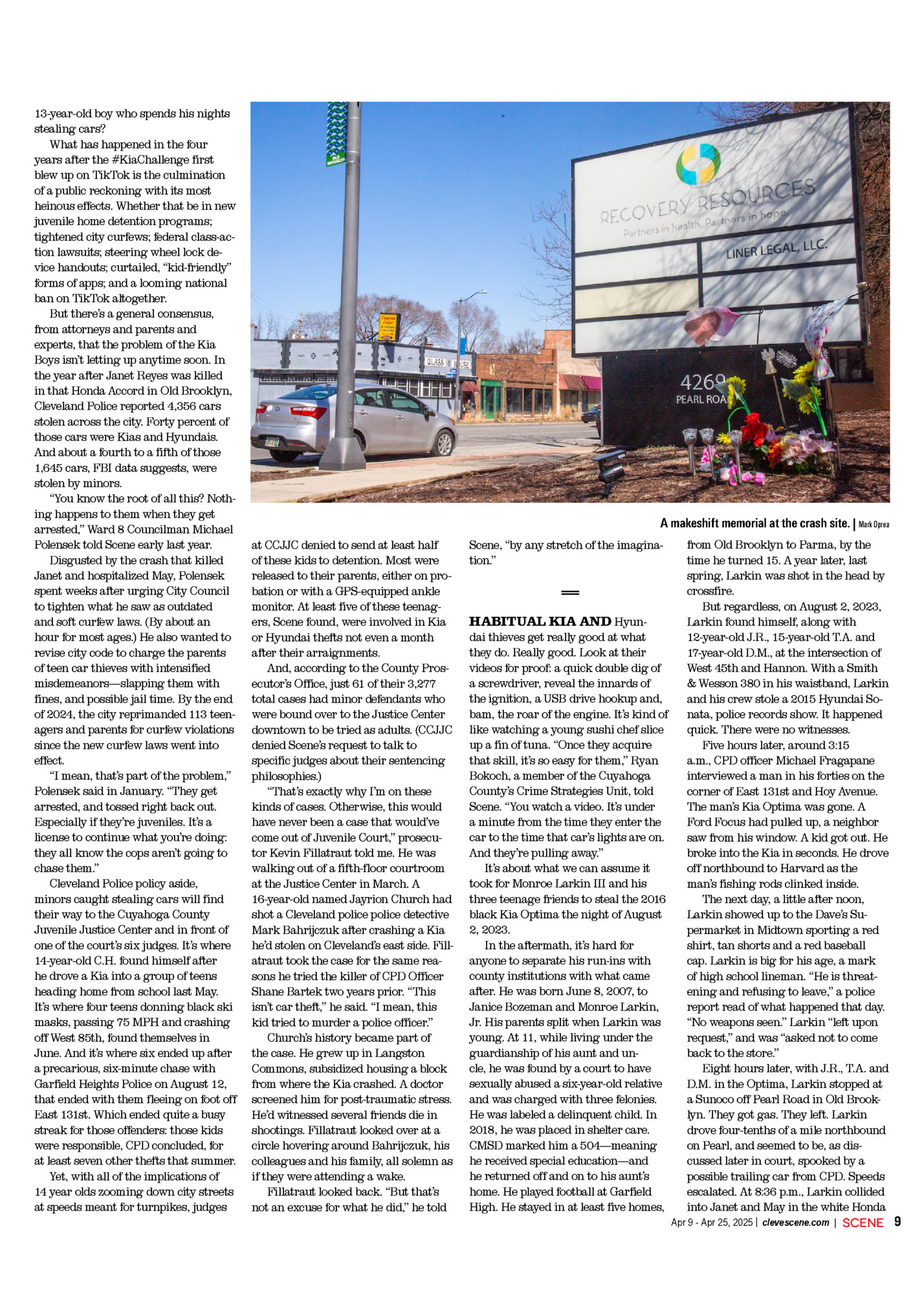
Fleepit Digital © 2021